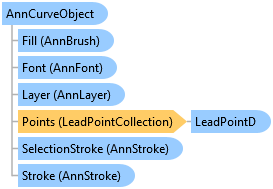
|
Products | Support | Email a link to this topic. | Send comments on this topic. | Back to Introduction - All Topics | Help Version 19.0.4.6
|

|
Products | Support | Email a link to this topic. | Send comments on this topic. | Back to Introduction - All Topics | Help Version 19.0.4.6
|
| Leadtools.Annotations.Core Namespace : AnnCurveObject Class |

public class AnnCurveObject : AnnPolylineObject, IAnnObjectCloneable
'Declaration
Public Class AnnCurveObject Inherits AnnPolylineObject Implements IAnnObjectCloneable
public sealed class AnnCurveObject : IAnnObjectCloneable
@interface LTAnnCurveObject : LTAnnPolylineObject<NSCoding,NSCopying>
public class AnnCurveObject extends AnnPolylineObject
function Leadtools.Annotations.Core.AnnCurveObject()
The curve object is a spline curve that contains a collection of Leadtools.LeadPointD points, a Tension value and an AnnStroke.
Programmatically, the boundaries and location of the curve object can be controlled using the following properties:
Each object can be transformed with the following methods:
The AnnCurveObject class inherits a number of properties from the AnnObject class, providing support for font, stroke and fill characteristics. These properties are listed below:
The name of the curve object can be controlled using AnnObject.Labels property, inherited from the AnnObject class.
The boundaries and location of the curve object can be controlled using the following properties:
An object can be part of a group annotation object or part of a container object. It cannot be part of both a group and a container at the same time.
The following properties can also be used to programmatically set characteristics of an AnnCurveObject:
This example creates a curve object and adds it to the automation container.
 Copy Code
Copy Code
using Leadtools.Annotations.Automation; using Leadtools.Annotations.Core; using Leadtools.Codecs; using Leadtools.Annotations.WinForms; public void AnnCore_AnnCurveObject() { // assumes _automation is valid double inch = 720.0; // Add a red curve object AnnCurveObject curveObj = new AnnCurveObject(); // Set the points for curve curveObj.Points.Add(LeadPointD.Create(1 * inch, 2 * inch)); curveObj.Points.Add(LeadPointD.Create(2 * inch, 1 * inch)); curveObj.Points.Add(LeadPointD.Create(3 * inch, 2 * inch)); curveObj.Points.Add(LeadPointD.Create(4 * inch, 1 * inch)); // Set the tension curveObj.Tension = 0.8; // Set the stroke curveObj.Stroke = AnnStroke.Create(AnnSolidColorBrush.Create("Red"), LeadLengthD.Create(1)); // Add the object to the automation container _automation.Container.Children.Add(curveObj); }
using Leadtools.Converters; using Leadtools.Annotations.Automation; using Leadtools.Controls; using Leadtools.Annotations.Core; using Leadtools.Codecs; public void AnnCore_AnnCurveObject() { // assumes _automation is valid double inch = 720.0; // Add a red curve object AnnCurveObject curveObj = new AnnCurveObject(); // Set the points for curve curveObj.Points.Add(LeadPointDHelper.Create(1 * inch, 2 * inch)); curveObj.Points.Add(LeadPointDHelper.Create(2 * inch, 1 * inch)); curveObj.Points.Add(LeadPointDHelper.Create(3 * inch, 2 * inch)); curveObj.Points.Add(LeadPointDHelper.Create(4 * inch, 1 * inch)); // Set the tension curveObj.Tension = 0.8; // Set the stroke curveObj.Stroke = AnnStroke.Create(AnnSolidColorBrush.Create("Red"), LeadLengthDHelper.Create(1)); // Add the object to the automation container _automation.Container.Children.Add(curveObj); // Select the object _automation.SelectObject(curveObj); }